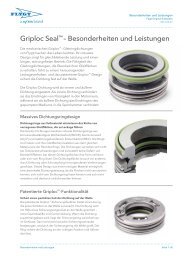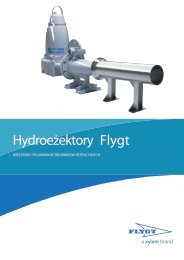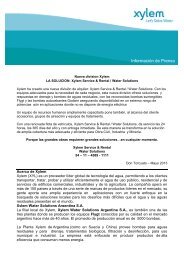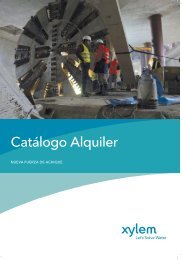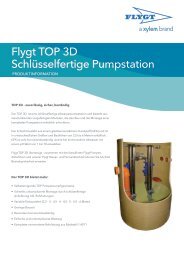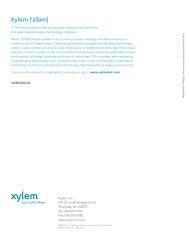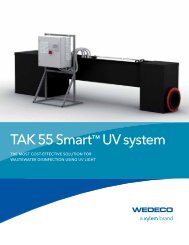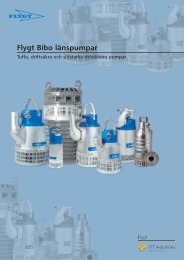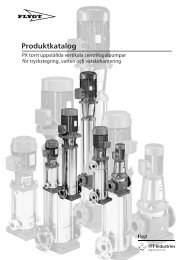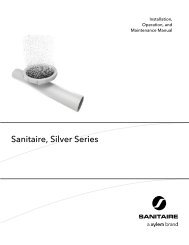WEDECO MiPRO™ Oxidation Solution Brochure
WEDECO MiPRO™ Oxidation Solution Brochure
WEDECO MiPRO™ Oxidation Solution Brochure
Create successful ePaper yourself
Turn your PDF publications into a flip-book with our unique Google optimized e-Paper software.
Why Advanced <strong>Oxidation</strong> Process<br />
Water utilities are reporting a worldwide rising<br />
trend as far as problematic micropollutions in<br />
water resources are concerned. Traces of organic<br />
/ anorganic pollutants like NDMA, MTBE, 1.4<br />
Dioxan, EDC, etc. are often found in ground and<br />
surface water.<br />
The reasons for the increasing degree of contaminations<br />
are to be found in the process of industrialization,<br />
intensive agriculture as well as all-round medical provision<br />
for humans. Once these micropollutants enter the<br />
human food chain via drinking water, there is a long<br />
term risk to health or even to human or animal genetic<br />
material. Traditional treatment methods are no longer<br />
sufficient to guarantee complete removal of these<br />
contaminants.<br />
Due to climate and demographic changes, many water<br />
utilities are expecting further pollutions of the drinking<br />
water resources in the near future. As a consequence,<br />
there is a higher risk of water scarcity and thus there<br />
will be an increasing demand for direct or indirect reuse<br />
of wastewater for drinking water purposes.<br />
NDMA (N-Nitrosodimethylamine)<br />
»»<br />
Is highly toxic and a suspected human<br />
carcinogen<br />
»»<br />
Is a Industrial by-product / waste product of<br />
several industrial processes<br />
»»<br />
Is harmful in drinking water at minute<br />
concentrations<br />
»»<br />
Is difficult to remove from drinking water. It<br />
does not readily biodegrade, adsorb, or volatilize.<br />
As such, it cannot be removed by activated<br />
carbon and travels easily through soils.<br />
1.4 Dioxane<br />
»»<br />
Causes eye and respiratory tract irritations and<br />
is suspected of causing damage to the central<br />
nervous system, liver and kidney<br />
»»<br />
Used in solvent applications for the manufacturing<br />
sector, in fumigants or automotive coolant.<br />
Partly contained in cosmetics products,<br />
such as deodorants, shampoos, toothpastes<br />
and mouthwashes.<br />
»»<br />
Forms contamination plumes in groundwater<br />
when released to the environment<br />
»»<br />
Difficulty removal since it does not readily bind<br />
to soils and is resistant to naturally occurring<br />
biodegradation processes.<br />
Pesticides<br />
»»<br />
are one of the causes of water pollution since<br />
only a minor portion of the applied amount is<br />
incorporated by the target species.<br />
»»<br />
are partly persistent organic pollutants and<br />
contribute to soil contamination<br />
»»<br />
causes particularly pollutants of surface water,<br />
i.e. due to runoff from agricultural areas draining<br />
into a river (Nonpoint Source Pollution)<br />
Residuals of Pharmaceuticals<br />
»»<br />
ends up in the environment via sewage from<br />
bodily excretion or improper disposal of<br />
unused pharmaceuticals. Main influx paths in<br />
surface waters are municipal wastewater treatment<br />
plants, drainage from the pharmaceutical<br />
industry animal breeding grounds or medical<br />
centres<br />
»»<br />
Are partly persistent. As a result, the number<br />
of contaminants in our water circulation<br />
and its consumers is creeping upwards<br />
(bioaccumulation)<br />
»»<br />
may cause endocrine effects on humans and<br />
animals<br />
2




